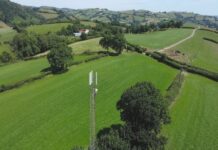Scientists developing way of using waste plastic to create car fuel
Discarded plastic could be used to fuel cars in the future thanks to a ground-breaking process developed by scientists from Swansea University.
They have been able to transform unwanted plastic into hydrogen which in turn could be used to run cars.
Dr Moritz Kuehnel, of the University’s chemistry department, told the BBC how light-absorbing material are added to the plastic, before it is placed in an alkaline solution and then exposed to sunlight, which creates hydrogen.
He said this process could be cheaper than recycling because any kind of plastic can be used and it does not need to be cleaned first.
“There’s a lot of plastic used every year – billions of tonnes – and only a fraction of it is being recycled. We are trying to find a use for what is not being recycled,” he said.
Most plastic bottles are made from PET [polyethylene terephthalate] which can be recycled but often end up being burned or thrown into landfill.
Dr Kuehnel said: “But even if you do recycle it, it needs to be very pure – so only PET, nothing else mixed in with it… and it has to be clean, no grease, no oil.
“Potentially you need to wash it which is very expensive, and even if you do all of that, the plastic you get isn’t always as nice as virgin material.”
He added: “The beauty of this process is that it’s not very picky. It can degrade all sorts of waste.
“Even if there is food or a bit of grease from a margarine tub, it doesn’t stop the reaction, it makes it better.
“The process produces hydrogen gas. You can see bubbles coming off the surface. You can use it, for example, to fuel a hydrogen car.”
However, he warned that rolling out the project on an industrial level may still be years away.
Dr Kuehnel added that the work, funded by the Engineering and Physical Sciences Research Council and an Austrian petrochemical company, had also shown how the remains of the plastic could be recycled to make new plastic.
Just one part of PET is used to produce the hydrogen and carbon dioxide – the other part stays intact and remains in the solution.
He said: “We get the hydrogen fuel and we get a chemical we can use to make new plastic.
“We don’t make a full new plastic, we use just half of the material to make new plastic and the rest can be recycled – a clean, clear water bottle out of plastic.”
Gwyddonwyr yn datblygu ffordd o ddefnyddio gwastraff plastig i redeg cerbydau
Fe allai gwastraff plastig cael ei ddefnyddio i redeg cerbydau yn y dyfodol, diolch i broses arloesol sydd wedi cael ei ddatblygu gan wyddonwyr ym Mhrifysgol Abertawe.
Mae’r gwyddonwyr wedi llwyddo i drawsnewid gwastraff plastig mewn i hydrogen, a’r gobaith yw y bydd modd ei ddefnyddio i redeg cerbydau.
Esboniodd Dr MoritzKuehnel o adran gemeg Prifysgol Abertawe wrth y BBC bod y broses yn cynnwys ychwanegu deunydd sy’n amsugno golau i blastig, ei roi mewn sylwedd a’i osod yng ngolau’r haul, sydd yna’n creu hydrogen.
Dywedodd y byddai’r broses hwn yn rhatach nag ailgylchu plastig oherwydd nid oes angen glanhau’r plastig yn gyntaf.
“Mae biliynau o dunelli o blastig yn cael ei ddefnyddio bob blwyddyn, a dim ond canran ohono sy’n cael ei ailgylchu,” meddai.
Mae’n rhan fwyaf o boteli plastig yn cael ei wneud o blastig PET [polyethyleneterephthalate] ac fe ellir ei ailgylchu ond yn ymarferol dydy hynny ddim o hyd yn digwydd.
Dywedodd Dr Kuehnel: “Ond hyd yn oed wrth ailgylchu, mae’n rhaid iddo fod yn bur – PET yn unig, heb ei gymysgu ag unrhyw beth arall, ac mae’n rhaid iddo fod yn lân, dim saim nag olew.”
Ychwanegodd fod golchi’r plastig yn ddrud iawn, a’i fod ddim yn cael ei ailddefnyddio’n aml oherwydd nad yw wastad cystal â phlastig newydd sbon.
“Rhagoriaeth y broses yma yw bod yn gallu dirywio pob math o wastraff. Hyd yn oed os mae ‘na fwyd neu rywfaint o saim o dwb margarîn, dydy’r adwaith ddim yn cael ei atal, mae’n ei wella.
“Mae’r broses yn cynhyrchu nwy hydrogen. Rydych yn gweld swigod yn dod ohono. Fe allwch chi ei ddefnyddio, er enghraifft, i redeg car hydrogen.”
Fodd bynnag, rhybuddiodd Dr Kuehnel fe all gymryd blynyddoedd cyn dechrau defnyddio’r dechnoleg ar lefel ddiwydiannol.
Mae’r gwaith yn cael ei wneud gyda labordy yng Nghaergrawnt yn sgil cyllid gan y Cyngor Ymchwil Peirianneg a Gwyddorau Ffisegol a chwmni petrocemegol o Awstria.
Ychwanegodd Dr Kuehnel bod modd creu plastig newydd, glân o’r hyn sy’n weddill ar ôl cynhyrchu’r hydrogen.
Help keep news FREE for our readers
Supporting your local community newspaper/online news outlet is crucial now more than ever. If you believe in independent journalism, then consider making a valuable contribution by making a one-time or monthly donation. We operate in rural areas where providing unbiased news can be challenging. Read More About Supporting The West Wales Chronicle























